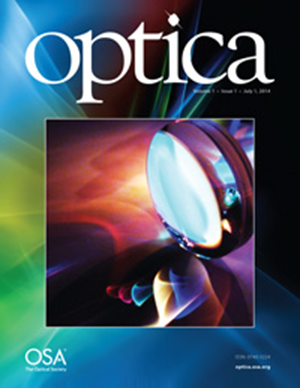几周期结构光脉冲的现场分辨时空特性分析
IF 8.5
1区 物理与天体物理
Q1 OPTICS
引用次数: 0
摘要
近几十年来,伴随着超快激光平台的快速发展,超短激光脉冲的时空操控引起了广泛关注,这是因为结构光具有尖端应用的潜力,包括光镊子、光通信、超分辨率成像、分子和量子材料的时间分辨光谱学以及强场物理学。如今,人们非常需要能够表征结构光的全部空间、时间和偏振态特性的技术。在此,我们展示了一种用于表征结构化中红外波形的技术,称为三维 TIPTOE,该技术仅使用一个二维硅基图像传感器作为探测器和非线性介质。三维 TIPTOE 技术结合了非线性激励所提供的亚周期时间分辨率和二维传感器固有的空间分辨率的优势,可对结构化电场进行全面表征,与其他技术相比,大大降低了检测的复杂性。通过测量几周期贝塞尔-高斯脉冲和径向极化飞秒矢量光束,证明了该技术的有效性。本文章由计算机程序翻译,如有差异,请以英文原文为准。
Field-resolved space–time characterization of few-cycle structured light pulses
Accompanied by the rapid development of ultrafast laser platforms in recent decades, the spatiotemporal manipulation of ultrashort laser pulses has attracted much attention due to the potential for cutting-edge applications of structured light, including optical tweezers, optical communications, super-resolution imaging, time-resolved spectroscopy in molecules and quantum materials, and strong-field physics. Today, techniques capable of characterizing the full spatial, temporal, and polarization state properties of structured light are strongly desired. Here, we demonstrate a technique, termed 3D TIPTOE, for characterizing structured mid-infrared waveforms, which uses only a two-dimensional silicon-based image sensor as both the detector and the nonlinear medium. By combining the advantages of the sub-cycle time resolution afforded by nonlinear excitation and the spatial resolution inherent to the two-dimensional sensor, the 3D TIPTOE technique allows full characterization of structured electric fields, significantly reducing the complexity of detection compared to other techniques. The validity of the technique is established by measuring both few-cycle Bessel–Gaussian pulses and radially polarized femtosecond vector beams.
求助全文
通过发布文献求助,成功后即可免费获取论文全文。
去求助
来源期刊

Optica
OPTICS-
CiteScore
19.70
自引率
2.90%
发文量
191
审稿时长
2 months
期刊介绍:
Optica is an open access, online-only journal published monthly by Optica Publishing Group. It is dedicated to the rapid dissemination of high-impact peer-reviewed research in the field of optics and photonics. The journal provides a forum for theoretical or experimental, fundamental or applied research to be swiftly accessed by the international community. Optica is abstracted and indexed in Chemical Abstracts Service, Current Contents/Physical, Chemical & Earth Sciences, and Science Citation Index Expanded.
 求助内容:
求助内容: 应助结果提醒方式:
应助结果提醒方式:


